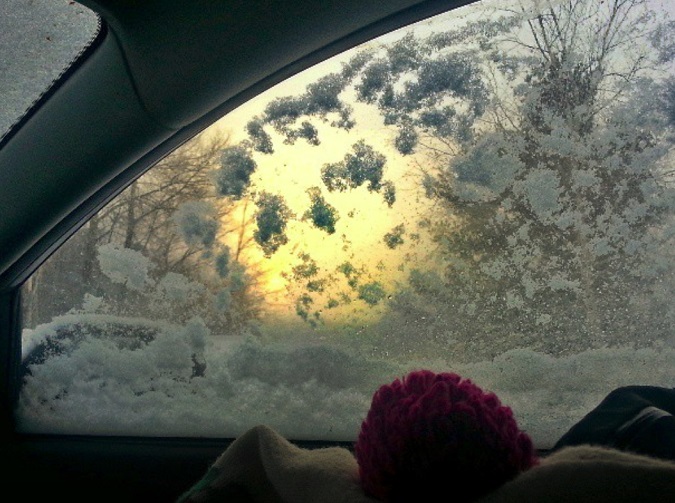It’s here: the cusp of a season turnover. Summer’s leaves are intermingling with red and gold, evenings are comfier with long-sleeves, and the morning air seems to “smell” colder, bringing with it crisp invigoration.

Those dipping temps also means many women, who are more susceptible to cold, are calling it quits on camping until summer’s warmth is back. But hold on: don’t pack away the tent just yet! Camping in the cooler months affords stunning scenery for ladies willing to brave beyond the first frost. Extend the camping season with the following tips and tricks.
Tent
Look for a tent with at least a three-season rating. If you’re camping in freezing conditions or snow, a four-season tent might be a better investment or, for optimum warmth, dig yourself a snow shelter; you’ll be surprised at the insulating effects.
Things to look for:
• Good fly coverage: A fly that envelops the tent and can be staked down to the ground will minimize chilly air and keep wind from creeping in.
• Vents that can be closed: A top vent that can be opened to allow condensation to escape during the night but closed during inclement weather is one feature to consider. Also up for thought: mesh panels that have a second, solid layer that can be zipped against wind.
Sleeping Bag
While down is considered the best insulator out there, its insulation properties can be completely negated by moisture. If you are heading somewhere dry it is a great option for warmth, but if there’s danger of precipitation falling on your bag, go with synthetic.
Things to look for:
• Check ratings: Bags are rated for the lowest temperature they can generally keep their occupants comfortable in. Keep in mind that men’s/universal bags are rated for men’s comfort, so the same bag might be chilly for women, who sleep a little on the cooler side. To get equally insulated, go with a bag rated 10° below what you need, or choose a women’s specific bag.
• Features: Look for mummy (hooded) bags which allow you to cinch yourself in, covering all but your nose and mouth. This creates a seal and keeps body heat in. Extra insulation in the foot of the bag is especially helpful for women with cold feet.
• Get the fit right: You want a gap between you and the bag when you are inside. This not only provides wiggle room, but also creates an air pocket that adds an additional insulating layer. Get a bag too tight and you lose that; too large and your body won’t be able to efficiently heat the extra space.
Sleeping Pad
While air pads are the comfiest, they can be bulky and, unless they have foam in their structure, provide very little in the way of insulating you from the cold ground—a major component in heat loss. Invest in a closed-cell foam pad or a self-inflating foam pad which combines the best of both worlds by reducing heat loss and adding comfort.
Layers
Unless you are wearing specially treated cotton, ditch the fabric. It retains any moisture you give off and keeps it next to your skin. The result: a chilly night of shivering. Instead, opt for synthetic or silk fabrics that move moisture away from your skin, or wool which continues to insulate even when wet.
Additionally, don’t don bulky layers before tucking in for the night, but don’t go naked, either. Though it seems counterintuitive, a simple, clean base layer and a hat are the perfect sleepwear; wearing heavy layers will cause compression against your bag and defeat its ability to keep in body heat. If needed, place those extra layers on the outside of your bag to create air pockets and trap heat.
Still cold? Try a lightweight liner which can add 10-20° to your bag’s rating.
P.S. Sleeping naked is only appropriate in certain cases—one is when no appropriate, dry clothing is available and the other is—well, a discussion for an entirely different article.
Site Selection
The properly selected site can do miracles to alleviate your cold camping blues. Some suggestions:
• Avoid placing your tent near bodies of water. Though a babbling brook may soothe you to sleep in the summer, it also creates a microclimate of cooler air which counteracts efforts to stay warm.
• If wind is an issue, look for a natural feature that will block those breezes then hug your tent up next to it. Examples include boulders, trees, or even a dense growth of tall grasses.
• Low-lying areas are cold sinks; avoid these by moving to higher ground, but avoid summits where exposure to wind can be an issue.
Tiny Tricks with Big Results
Like being armed with a bag of tricks? The outdoor women of social media chimed in to offer their solutions on staying warm. Give one or all a try!
• Remove dead air space: Jillian Bejtlich stuffs the next day’s clothes at the bottom of her sack, a tip that is especially useful when the sleeping bag is too large. This reduces the amount of body heat needed to warm the bag. Bonus: clothes are warmed for the next morning!
• Nalgene bottle: Heather Balogh fills a hard plastic bottle with hot water and sticks it in the bottom of her bag to help the raise its ambient temperature.
• Midnight snack: The ladies at Off the Grid Outdoor Adventures chomp on a snack before bed. Try munching on something high in protein which will keep your digestive system working longer than simple sugars.
• Activate heat: Beverly Hill uses air-activated charcoal heat packs to fend off chills, especially in the humid south where the cold seems to persist despite all other efforts. Place these packs near body areas that are especially susceptible to cold and at pulse points.
• Body heat: And finally, a tried and true favorite. Kate Jenkins suggests the classic cuddling technique to keep warm. Instructions are simple: Find someone you like and keep close. The shared body heat, which radiates even through thick sleeping bags, will do wonders! Alternatively, zip two Teton Sports bags together—hey, they’re designed for that!
And my own personal favorites:
• Drink a little water about an hour before bed, then hit the bathroom right before bedtime. This hydrates your body which aids in blood circulation, but helps you to avoid a chilly restroom run (and subsequent heat loss) in the middle of the night.
• Light exercise (not enough to sweat!) gets the blood pumping and gives off excess heat, so do a few jumping jacks before zipping in to trap in the warmth.
• Make sure your skin and hair are thoroughly dry—especially those feet!—before falling asleep. Cornstarch (avoid scented baby powder in bear country) can aid in absorption if necessary.
Got your own suggestions for staying warm? Leave a comment to share it with the community!
By Gina Begin from Teton Sports

